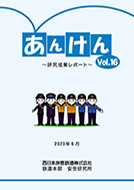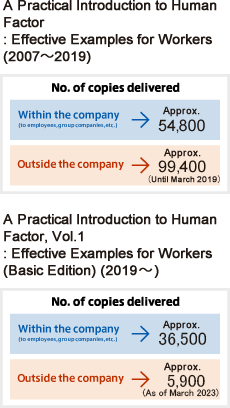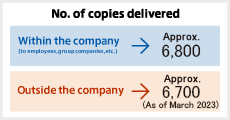About Us
Safety Research Institute
Major Research Topics
- Basic research on mechanisms of a chain of errors
- Research on Work Engagement in Road Industry
- Effects of perceived importance of on lapse errors in the last phase of a task
- Research on measures for preventing sleepiness in train drivers, etc.
- Research on measures to cope with irregular situations
- Assessment of the effects of Human Factor Education
- Research on prevention of railway accidents caused by human error
- Research on sleepiness of night shift
- Research on mental load caused by safety fence on platform during driving trains
- How to develop the cognitive skills related risks in working environment
- Research on changes in interpersonal behavior when given a role or power
- Research for fostering a work environment where it is easy to speak up
- Research on the impact of aging on the work of railway staff
- Research on appropriate leadership behavior in the workplace
- Research on human-machine interaction
- Research on sound volume of alarm suitable for driving trains
- Evaluation of monitors‘ visibility for checking passengers flow
- Process of driving operation in system change of train cab environment
- Research on design of control panel in train cabs of 227 Series
- Age-related differences in appropriate local lighting conditions for visual inspection of machines and equipment such as railroad vehicles
- Research on measures for intoxicated individuals on the platform
- Research on preventing accidents caused by using smartphone at stations
- Evacuation behaviors and rescue activities in railroad tunnel fire accidents
- Research on behavioral characteristics of elderly driver on level crossings
Anken, Vol. 16 — Research Results Report

The 16th volume of “Anken” included a summary of the Safety Research Institute’s 2022 research results.
Anken, Vol. 16 — Research Results Report (PDF; 3,083 KB)
-
-
 Report of preliminary experiment on the trait of behavior when encountering problems difficult to solve
Report of preliminary experiment on the trait of behavior when encountering problems difficult to solve

-
Our aim was to grasp how people think and behave when they encounter some situation in which they find it too difficult to solve their problem, such as sudden mechanical troubles and to understand how and why they get stuck in the situation. In this study we used some quiz-like tasks called “insight problem.” To solve the problem, a radical restructuring of the initial idea is required. Here we report the results of our preliminary experiment.
-
-
-
 Study on improvement of risk sensitivity: investigation regarding how to better disseminate incident information
Study on improvement of risk sensitivity: investigation regarding how to better disseminate incident information

-
When an incident occurs in the workplace, it is important to disseminate the information within the company to prevent the recurrence of similar events. In this study, our aim was to establish what measures should be taken when providing this information to increase the likelihood that workers will identify potential risk factors in the workplace.
In the field of memory research, the “self-reference effect” is well known. It refers to the phenomenon whereby the memory of the object the person memorizes in connection with themselves would keep better.
In this study, we carried out an experiment to examine this effect in conditions close to reality, assuming a situation in which risk information is provided.
-
-
-
 Study to develop a work environment for workers to express their opinions easily
Study to develop a work environment for workers to express their opinions easily

-
Workplace accidents and mistakes can happen when workers cannot express what they should or want to say because they cannot discuss critical problems under these circumstances.
We conducted this study to prevent hazardous workplace incidents caused by workers not expressing their opinions in the workplace. Previously we conducted some investigations to better understand how “the degree workers are willing to express their opinion” and “psychological safety” affects “safety behavior”. However, in those studies we selected the participants randomly from ordinary workers, which made it impossible to control for such variables as specific workplace or workplace organization in our analysis. Thus, this time we carried out a survey of workers belonging to specific and identified engineering workplaces and analyzed the data by workplaces as well as individuals. Here, psychological safety means “the belief of workers that their team will be safe when taking interpersonal risks” and that they have an atmosphere where they can talk freely about their concerns that are challenging to express. It is said that in a workplace with high psychological safety workers tend to have low interpersonal anxiety and proactively express their ideas, doubts, and concerns.
-
-
-
 Study on diversity of working styles and appropriate workplace communication
Study on diversity of working styles and appropriate workplace communication

-
Workstyles have dramatically changed due to the COVID-19 pandemic. These changes include the spread of teleworking and online tool use, which have significantly affected the methods and the quality of workplace communication. These changes might affect human relationship in the workplace and work efficiency. Thus, in this study we conducted a survey research in order to grasp how people were actually teleworking. The study was conducted at the point two years after they were forced to start teleworking because of the COVID-19 pandemic. We then examined how workers perceived the impact of changes in communication on workplace relationships and work efficiency.
We also clarified the relationship between differences between how they perceived the impact and how they were actually teleworking. Here we report some of findings obtained through the survey.
-
-
-
 Survey on Work Engagement within the railway industry
Survey on Work Engagement within the railway industry

-
Work Engagement (WE) is defined as “the positive and fulfilling work-related mental condition characterized by vigor, dedication, and absorption.” It’s said that employees with high WE are positively involved in their work, that WE increases when workers have appropriate job resources, such as job discretion or support from managers and coworkers. It has also been shown that job performance improves when WE increases.
As in the previous study we conducted this survey to test the hypothetical model in which job resources lead to WE, which in tern leads to safe behavior and safety awareness.
In addition, in this study we set up and tested an additional model in which we replaced some independent variables according to the hypothesis that job resources includes "psychological safety“. "psychological safety” refers to the atmosphere in which people are willing to express their opinions without taking interpersonal risk.
Employees working at Company A, a railroad company, participated in our survey.
-
Previous Main Research Results
-
Up to 2021
-
Up to 2020
-
Up to 2019
-
Up to 2018
-
Up to 2017
-
Up to 2016
-
Up to 2015
-
Up to 2014
-
Up to 2013
-
Up to 2012
-
Up to 2011
-
Up to 2010
-
Up to 2009
-
Up to 2008
-
Up to 2007
All rights reserved. Copying without express permission is prohibited.
Our Teaching Materials
A Practical Introduction to Human Factor, Vol.1: Effective Examples for Workers (Basic Edition)
The Safety Research Institute published the textbook, “A Practical Introduction to the Human Factor: Effective Examples for Workers” in March 2007, and has distributed over 150,000 copies of this book inside and outside the company by March 2019. This textbook explains human factors using simple expressions in an easy-to-understand way. The book is used for education in human factors inside and outside the company. Over ten years have passed since publishing the first edition of the book, and we have revised its content by adding information on the normalcy bias, confirmation bias and incorporating knowledge and achievements gained from research activities during the last ten years. We updated “For better understanding and disseminating human factors” and published “A Practical Introduction to the Human Factor,Vol.1 Effective Examples for Workers (basic edition, 89 A4 pages).”


A Practical Introduction to the Human Factor, Vol.2: Effective Examples for Team Leaders
In March 2017, A Practical Introduction to the Human Factor, Vol.2: Effective Examples for Team Leaders was introduced as a sequel to A Practical Introduction to the Human Factor: Effective Examples for Workers with a focus on academic research as well as the previous book. This follow-up included teaching materials that focused on information management supervisors on the industry frontlines should know, and was distributed to employees and group companies on the industry frontlines. Continuing on from the first publication, A Practical Introduction to the Human Factor, Vol.2: Effective Examples for Team Leaders introduced topics (7 in total) geared toward management supervision in an easy-to-understand way using familiar events as examples and with various illustrations and charts. (A4 size, 50 pages)
The Safety Research Institute sent representatives to branch offices to give lectures related to this publication as well, including on methods for utilizing the teaching materials contained within.
(Japanese text only)


Handbook of Sleeping for Train crew
The Safety Research Institution published the Guidelines for Preventing Sleepiness of Train drivers: For Health and Safety for operators in November 2009. In an effort to prevent sleepiness in train crew members, the Safety Research Institute actively researches the body and sleep mechanisms of people based on academic studies as an essential factor in preventing sleepiness.
In March 2018, the "Handbook of Sleeping For Train Crews: For Safety and Health" was published with additions and revisions of new findings, and daily life items based on guidelines. (A4 size, 53 pages)




 Content Menu
Content Menu

 Search
Search HOME
HOME
